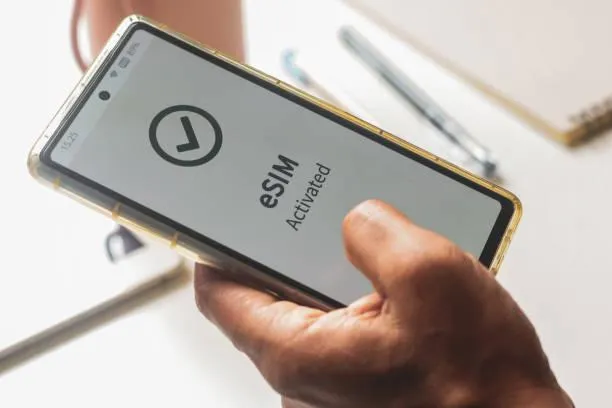
How eSIM Scams and Phone Tricksters Can Hurt Your Business
Protecting Your Business from eSIM Scams: What You Need to Know About Phone Number Takeovers
TL;DR (AKA THE SHORT VERSION)
As a business owner, you rely on your smartphone for everything—client calls, bank transactions, and managing your team. New technology called eSIMs makes it easier to switch phone plans or travel without swapping tiny SIM cards. Instead of a physical card, your phone stores your plan digitally. It’s convenient, but it comes with a hidden risk: scammers can hijack your phone number through a trick called “vishing” (voice phishing) by calling your mobile carrier. This can lead to stolen money, hacked accounts, or even business data leaks. In this post, we’ll explain the danger in simple terms, how it threatens your business, and easy steps to keep you safe.
What Are eSIMs and Why Should You Care?
An eSIM is like a digital version of the SIM card in your phone. It lets you activate a phone plan without a physical card, often through an app or a website. For example, if you’re traveling for a trade show or switching carriers, you can set up a new plan in minutes. Most new smartphones, like iPhones or Samsungs, use eSIMs, and big carriers like Verizon or T-Mobile support them.
The problem? Scammers love how easy eSIMs make it to take over your phone number. If they get control of your number, they can intercept your calls, texts, and even the codes banks send to verify it’s you. For a business owner, this could mean losing access to your bank account, email, or sensitive client information.
How Scammers Use Vishing to Steal Your Phone Number
Vishing is when scammers pretend to be someone trustworthy—like your mobile carrier—over the phone to trick people into giving up personal info. Here’s how they use vishing to target business owners like you:
They Do Their Homework: Scammers find details about you online, like your name, address, or even your business’s social media posts. Sometimes they buy stolen info from data leaks.
They Call Your Carrier: Pretending to be you, they call your mobile carrier (say, AT&T or T-Mobile) and say something like, “I lost my phone; I need to set up a new eSIM for my number.” They use the info they gathered to answer security questions, like your billing address or the last four digits of your ID.
They Take Over Your Number: If the carrier believes them, they send the scammer a code to activate a new eSIM. Suddenly, your phone stops working, and the scammer gets all your calls and texts. They can now access your bank accounts, reset your email passwords, or even pretend to be you to scam your clients.
This scam, called SIM swapping, is growing fast. In 2025, thousands of people, including business owners, lost money and data this way. eSIMs make it easier for scammers because they don’t need a physical SIM card—just a quick phone call or online request.
Why This Is a Big Deal for Your Business
Losing control of your phone number isn’t just annoying—it can hurt your business in serious ways:
Money Stolen: Scammers can use your number to get into your bank or payment apps, draining accounts or taking out loans in your name. One small business owner lost $50,000 after a SIM swap let hackers access their PayPal.
Hacked Accounts: If you use text messages for login codes (like for email or accounting software), scammers can take over those accounts. They might lock you out or steal sensitive data, like client contracts.
Client Trust at Risk: Scammers could pretend to be you, contacting clients to ask for payments or share fake deals, damaging your reputation.
Business Disruption: If your phone stops working, you can’t make calls, respond to clients, or manage daily tasks. For a small business, even a day offline can cost you.
Traveling business owners are especially at risk. Scammers target eSIMs used for travel plans, which are often set up quickly with less security.
Simple Steps to Protect Your Business
You don’t need to be a tech expert to stay safe. Here are practical steps to protect your phone number and business:
Add a PIN to Your Carrier Account: Call your mobile carrier and ask to set up a special PIN or password for your account. This makes it harder for scammers to make changes, even if they pretend to be you. Ask for a “SIM lock” or “account protection” feature—most carriers like Verizon or T-Mobile offer this.
Stop Using Texts for Logins: Many apps send a code to your phone to verify it’s you. These texts aren’t safe because scammers can intercept them. Instead, use an app like Google Authenticator for login codes. It’s free and works even if your number is stolen.
Watch Your Accounts Closely: Check your carrier’s app or website regularly to spot any strange changes, like a new device added. Sign up for a service like Experian or LifeLock to warn you if someone tries to open accounts in your name.
Be Suspicious of Calls: If someone claiming to be from your carrier calls you, hang up and call back using the official number on their website. Never share personal info like your Social Security number or account details over the phone.
Limit What You Share Online: Scammers use details from social media or public records to trick carriers. Avoid posting your full address, birthday, or phone number online. Be careful what your business shares, too, like employee names or travel plans.
If you travel a lot, choose trusted eSIM providers (like major carriers) and always double-check any activation emails or texts.
The Bottom Line: Stay One Step Ahead
eSIMs make running your business easier, but they also make it easier for scammers to target you through vishing calls to your carrier. A stolen phone number can lead to lost money, hacked accounts, and angry clients. By taking simple steps—like adding a PIN, avoiding text-based logins, and being cautious—you can protect your business without needing to understand the techy details. Stay alert, and if you’ve dealt with a phone scam before, let us know in the comments to help other business owners stay safe!


